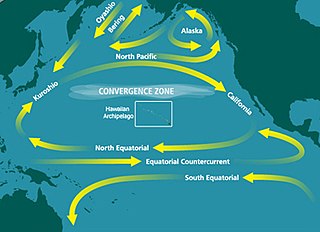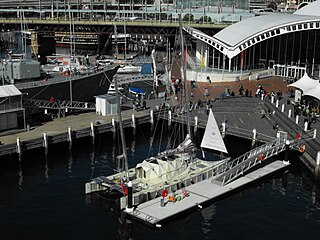
Marine debris, also known as marine litter, is human-created solid material that has deliberately or accidentally been released in seas or the ocean. Floating oceanic debris tends to accumulate at the center of gyres and on coastlines, frequently washing aground, when it is known as beach litter or tidewrack. Deliberate disposal of wastes at sea is called ocean dumping. Naturally occurring debris, such as driftwood and drift seeds, are also present. With the increasing use of plastic, human influence has become an issue as many types of (petrochemical) plastics do not biodegrade quickly, as would natural or organic materials. The largest single type of plastic pollution (~10%) and majority of large plastic in the oceans is discarded and lost nets from the fishing industry. Waterborne plastic poses a serious threat to fish, seabirds, marine reptiles, and marine mammals, as well as to boats and coasts.

The North Pacific Gyre (NPG) or North Pacific Subtropical Gyre (NPSG), located in the northern Pacific Ocean, is one of the five major oceanic gyres. This gyre covers most of the northern Pacific Ocean. It is the largest ecosystem on Earth, located between the equator and 50° N latitude, and comprising 20 million square kilometers. The gyre has a clockwise circular pattern and is formed by four prevailing ocean currents: the North Pacific Current to the north, the California Current to the east, the North Equatorial Current to the south, and the Kuroshio Current to the west. It is the site of an unusually intense collection of human-created marine debris, known as the Great Pacific Garbage Patch.

The Great Pacific Garbage Patch is a garbage patch, a gyre of marine debris particles, in the central North Pacific Ocean. It is located roughly from 135°W to 155°W and 35°N to 42°N. The collection of plastic and floating trash originates from the Pacific Rim, including countries in Asia, North America, and South America.

A garbage patch is a gyre of marine debris particles caused by the effects of ocean currents and increasing plastic pollution by human populations. These human-caused collections of plastic and other debris are responsible for ecosystem and environmental problems that affect marine life, contaminate oceans with toxic chemicals, and contribute to greenhouse gas emissions. Once waterborne, marine debris becomes mobile. Flotsam can be blown by the wind, or follow the flow of ocean currents, often ending up in the middle of oceanic gyres where currents are weakest.

Marine plastic pollution is a type of marine pollution by plastics, ranging in size from large original material such as bottles and bags, down to microplastics formed from the fragmentation of plastic material. Marine debris is mainly discarded human rubbish which floats on, or is suspended in the ocean. Eighty percent of marine debris is plastic. Microplastics and nanoplastics result from the breakdown or photodegradation of plastic waste in surface waters, rivers or oceans. Recently, scientists have uncovered nanoplastics in heavy snow, more specifically about 3,000 tons that cover Switzerland yearly.

Kamilo Beach, is a beach located on the southeast coast of the island of Hawaii. It is known for its accumulation of plastic marine debris from the Great Pacific Garbage Patch.

The Plastiki is a 60-foot (18 m) catamaran made out of 12,500 reclaimed plastic bottles and other recycled PET plastic and waste products. Michael Pawlyn of Exploration Architecture worked on the concept design with David de Rothschild and helped to shape some of the key ideas. The craft was built using cradle to cradle design philosophies and features many renewable energy systems, including solar panels, wind and trailing propeller turbines, and bicycle generators. The frame was designed by Australian naval architect Andrew Dovell. The boat's name is a play on the 1947 Kon-Tiki raft used to sail across the Pacific by Norwegian explorer Thor Heyerdahl, and its voyage roughly followed the same route.

Charles J. Moore is an oceanographer and boat captain known for articles that recently brought attention to the 'Great Pacific Garbage Patch', an area of the Pacific Ocean strewn with floating plastic debris caught in a gyre.

Project Kaisei is a scientific and commercial mission to study and clean up the Great Pacific Garbage Patch, a large body of floating plastic and marine debris trapped in the Pacific Ocean by the currents of the North Pacific Gyre. Discovered by NOAA, and publicized by Captain Charles Moore, the patch is estimated to contain 20 times the density of floating debris compared to the global average. The project aims to study the types, extent, and nature of the debris with a view to identifying the scope of the problem and its effects on the ocean biome as well as ways of capturing, detoxifying, and recycling the material. It was organized by the Ocean Voyages Institute, a California-based 501c3 non-profit organisation dealing with marine preservation. The project is based in San Francisco and Hong Kong.

The Indian Ocean gyre, located in the Indian Ocean, is one of the five major oceanic gyres, large systems of rotating ocean currents, which together form the backbone of the global conveyor belt. The Indian Ocean gyre is composed of two major currents: the South Equatorial Current, and the West Australian Current.

The North Atlantic garbage patch is a garbage patch of man-made marine debris found floating within the North Atlantic Gyre, originally documented in 1972. A 22-year research study conducted by the Sea Education Association estimates the patch to be hundreds of kilometers across, with a density of more than 200,000 pieces of debris per square kilometer. The garbage originates from human-created waste traveling from rivers into the ocean and mainly consists of microplastics. The garbage patch is a large risk to wildlife through plastic consumption and entanglement.

The Indian Ocean garbage patch, discovered in 2010, is a marine garbage patch, a gyre of marine litter, suspended in the upper water column of the central Indian Ocean, specifically the Indian Ocean Gyre, one of the five major oceanic gyres. The patch does not appear as a continuous debris field. As with other patches in each of the five oceanic gyres, the plastics in it break down to ever smaller particles, and to constituent polymers. As with the other patches, the field constitutes an elevated level of pelagic plastics, chemical sludge, and other debris; primarily particles that are invisible to the naked eye. The concentration of particle debris has been estimated to be approximately 10,000 particles per square kilometer.

The majority of environmental issues affecting Hawaii today are related to pressures from increasing human and animal population and urban expansion both directly on the islands as well as overseas. These include the unsustainable impacts of tourism, urbanization, implications of climate change such as sea level rise, pollution, especially marine plastic pollution, and invasive species.

Plastic pollution is the accumulation of plastic objects and particles in the Earth's environment that adversely affects humans, wildlife and their habitat. Plastics that act as pollutants are categorized by size into micro-, meso-, or macro debris. Plastics are inexpensive and durable, making them very adaptable for different uses; as a result, manufacturers choose to use plastic over other materials. However, the chemical structure of most plastics renders them resistant to many natural processes of degradation and as a result they are slow to degrade. Together, these two factors allow large volumes of plastic to enter the environment as mismanaged waste which persists in the ecosystem and travels throughout food webs.
The 5 Gyres Institute is a 501(c)(3) non-profit organization that focuses on reducing plastics pollution by focusing on primary research. Programs concentrate on science, education and adventure. Since 2017, 5 Gyres has been in special consultative status with the United Nations Economic and Social Council. The organization's 2015 Expedition was featured in the 2017 documentary "Smog of the Sea," produced by Jack Johnson, who participated in the voyage.
The Garbage Patch State – Wasteland is an ongoing transmedia, environmental artwork by Maria Cristina Finucci. The project aims to raise awareness about the environmental hazard of the Great Pacific Garbage Patch caused by the dispersion of plastic debris in the oceans. Installations, performances, and videos have been carried out under the patronage of UNESCO and the Italian Ministry of the Environment.

The Ocean Cleanup is a nonprofit environmental engineering organization based in the Netherlands that develops technology to extract plastic pollution from the oceans and to capture it in rivers before it can reach the ocean. Their initial focus was on the Pacific Ocean and its garbage patch, and extended to rivers in countries including Indonesia, Guatemala, and the United States.
The Plastic Pollution Coalition (PPC) is an advocacy group and social movement organization which seeks to reduce plastic pollution. PPC operates under the fiscal sponsorship of the umbrella organization Earth Island Institute.

The South Pacific garbage patch is an area of ocean with increased levels of marine debris and plastic particle pollution, within the ocean's pelagic zone. This area is in the South Pacific Gyre, which itself spans from waters east of Australia to the South American continent, as far north as the Equator, and south until reaching the Antarctic Circumpolar Current. The degradation of plastics in the ocean also leads to a rise in the level of toxics in the area. The garbage patch was confirmed in mid-2017, and has been compared to the Great Pacific Garbage Patch's state in 2007, making the former ten years younger. The South Pacific garbage patch is not visible on satellites, and is not a landmass. Most particles are smaller than a grain of rice. A researcher said: "This cloud of microplastics extends both vertically and horizontally. It's more like smog than a patch".
















